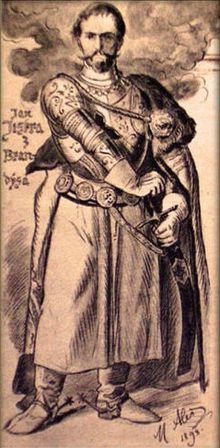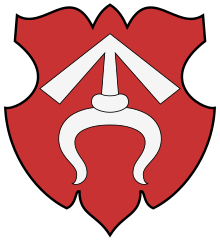Johann Giskra
Johann Giskra von Brandeis ( Czech Jan Jiskra z Brandýsa , Slovak Ján Jiskra z Brandýsa , Hungarian Giskra János ; * around 1400; † 1469/1470) was a Bohemian nobleman.
Life
Griska came from the Moravian noble family of the Lords of Brandeis . His father was probably Alšík von Brandýs. Other sources assume that he was a son of Jan Lysek von Brandýs and grew up at Gansberg Castle . He received his training as a warrior in Italy . According to some sources, he is said to have participated in the naval battles of the Venetians . In Bohemia he later adopted the tactics of the Hussites . After the Battle of Lipan , he joined some other mercenaries in the service of King Sigismund and fought against the Turks near Belgrade .
After the death of King Sigismund, the Hungarian king widow Elisabeth von Luxemburg, who ruled for the minor King Ladislaus Postumus , called a mercenary army under Jan Giskra to support the rival Jagiellonian Władysław , who was also crowned king . These mercenaries established themselves in the Hungarian uplands , and Giskra received the mines' income, collected taxes, garrisoned the area's royal castles, and captured castles belonging to the supporters of his rival Wladyslaw.
With 5,000 men he occupied central Slovakia and part of eastern Slovakia. In doing so, he interrupted the direct route between Hungary and Poland. In Kremnitz he had his own thalers minted and thus secured the financing of the siege.
King Władysław at the time had no opportunity to pose a threat to Giskra, as most of his armies had to fight the Turkish invasion, so he concluded a standstill agreement with him, which he extended several times. After Władysław was lost after the Battle of Varna and his armies were defeated, Giskra was appointed one of the seven captains who administered Hungary . Basically, his rule referred to Slovakia, where he is said to have had his seat in the castle Pustý hrad near Altsohl and in Košice . After Johann Hunyadi was elected governor of Hungary, military conflicts broke out again in 1446, which were interrupted by brief peace agreements.
In 1449 Giskra defeated the Hungarian army north of Košice. In January 1450 a meeting was called in Ofen , which on March 31, 1450 negotiated a peace agreement. However, the peace did not last long and on September 7, 1451, Hunyadi was defeated at the Battle of License , after which a peace agreement was again concluded.
1453 Giskra was relieved of his powers by Ladislaus Postumus. He left Hungary and most of his army joined the military leader Petr Aksamit . In 1454 Giskra was commissioned to fight the Brethren movement . After Matthias Corvinus took office on the Hungarian throne in 1458, Giskra withdrew to Poland. Here he helped with the peace negotiations between Poland and the Teutonic Knights Order and offered King Casimir IV Jagiełło help in the fight for the Hungarian throne.
Negotiations began with the Hungarian king, from which Giskra promised to preserve his Slovak (= Upper Hungarian) possessions. In April 1462, after the conclusion of a contract between Matthias Corvinus and Emperor Friedrich III. , Corvinus took Giskra into his service in the spring of 1462, after lengthy, albeit rarely consistent military efforts, promoted him to baron and gave him the castle near Iňačovce , the lands near Arad and the castle near Lippa in the Banat .
Matthias Corvinus raised a mercenary army, which mainly consisted of Johann Giskra's soldiers. Known as the Black Army , this powerful force was successful in various battles, but was also known for looting when it failed to pay. So on December 2, 1462 Giskra took the Wallachian prince Vlad III. Drăculea captured by a deception and handed him over to the Hungarian king. Furthermore, the Black Army fought against Turks and their allies such as the Duke of Wallachia Stephan the Great . In January 1467, Giskra made peace with Sultan Mehmet II on behalf of Corvinus .
Giskra spent 22 years of his life in Slovakia. As a military leader, he always sympathized with his soldiers. Nor did he belong to the Hussites , as is sometimes claimed, but was a Catholic with friendly relations with the Bohemian nobility, who was led by Ulrich II von Rosenberg , who opposed the Hussite movement.
Pope Aeneas Silvius Piccolomini referred to him in his memoirs as one of the famous men of his time ( De viris illustribus ).
The date and cause of his death are not known. It was last listed in a property register on October 22nd, 1468. In the royal bull of February 6, 1471, he is already described as dead.
reception
Through the imperial resolution of Franz Joseph I of February 28, 1863, Johann Giskra von Brandeis was added to the list of the most famous warlords and generals of Austria worthy of perpetual emulation , in their honor and memory there was also a life-size statue in the general hall of the then new erected k. k. Hofwaffenmuseums (today: Army History Museum Vienna ) was built. The statue was created in 1871 by the sculptor Rudolf Dominik Zafauk (1830–1889) from Carrara marble and was dedicated by Emperor Franz Joseph himself.
literature
- Wilhelm Edler von Janko : Giskra von Brandeis, Johann . In: Allgemeine Deutsche Biographie (ADB). Volume 9, Duncker & Humblot, Leipzig 1879, p. 202 f.
- Václav Chaloupecký : Jiskra z Brandýsa . In: Karel Stloukal (ed.): Tvůrcové dějin. čtyři tisíciletí světových dějin v obrazech dob a osobností . Volume 2: Středověk . L. Mazáč, Prague 1934, pp. 537-544.
- Miloslav Vach: Jan Jiskra z Brandýsa a politický zápas Habsburků s Jagellovci o Uhry v letech 1440–42 . In: Historické štúdie 3, 1957, ZDB -ID 281840-1 , pp. 172–227.
- Béla Grolshammer: Jiskra, Jan z Brandýsa . In: Biographical Lexicon on the History of Southeast Europe . Volume 2. Munich 1976, p. 269 f.
Individual evidence
- ↑ http://www.obeclipov.cz/vismo/dokumenty2.asp?id_org=8436&id=7924&p1=316
- ↑ Johann Christoph Allmayer-Beck : The Army History Museum Vienna. The museum and its representative rooms . Kiesel Verlag, Salzburg 1981, ISBN 3-7023-0113-5 , p. 30
| personal data | |
|---|---|
| SURNAME | Giskra, Johann |
| ALTERNATIVE NAMES | Giskra von Brandeis, Johann |
| BRIEF DESCRIPTION | bohemian nobleman |
| DATE OF BIRTH | around 1400 |
| PLACE OF BIRTH | Brandýs nad Orlicí |
| DATE OF DEATH | 1469 or 1470 |

